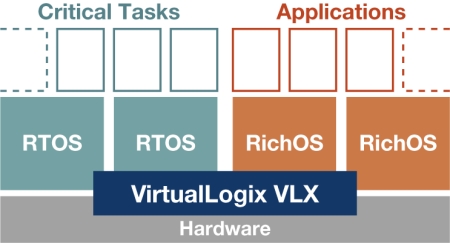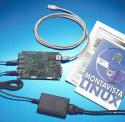Phone virtualization specialist offers demoware
Feb 6, 2007 — by LinuxDevices Staff — from the LinuxDevices Archive — 2 viewsVirtualLogix (formerly Jaluna) is prepping an evaluation version of its platform virtualization software for mobile handsets. VLX-MX (“Mobile Experimentation”) will be freely available this quarter, and will help qualified prospective customers explore, benchmark, and otherwise evaluate the company's virtualization technology for mobile handsets, it says.
VXL-MX is based on the company's VLX-MH (“Mobile Handsets”) product. VLX-MH was designed to enable legacy phone RTOSes to share application processor resources with Linux and/or another rich phone OS, enabling multimedia functionality and modern connection options to be grafted onto existing mobile phone designs.

VLX architecture
VLX-MX was designed to enable prospective VLX-MH customers to thoroughly evaluate the company's mobile virtualization technology without incurring any upfront costs or obligation, according to VP of Marketing Mark Milligan. “We're a 'try-and-buy' society. VLX-MX will enable customers to see how it works with the RTOS they already have,” he noted.
Milligan adds that VLX-MX is “not deployable,” due to licensing stipulations, as well as “stuff inside the software” designed to thwart production use. However, the image should give potential customers a good idea of what to expect from VirtualLogix's full VLX-MH stack, Milligan said.
 VirtualLogix's full VLX-MH product supports a range of ARM-based processors, development boards, and hardware designs, including a Philips NXP reference design. However, VLX-MX will be available initially with support only for TI's OMAP5912 application processor and low-cost (about $300) OMAP5912 Starter Kit (pictured at right).
VirtualLogix's full VLX-MH product supports a range of ARM-based processors, development boards, and hardware designs, including a Philips NXP reference design. However, VLX-MX will be available initially with support only for TI's OMAP5912 application processor and low-cost (about $300) OMAP5912 Starter Kit (pictured at right).
And, whereas the full-blown VLX product is available pre-integrated with a range of commercial RTOSes, VLX-MX is designed to demonstrate two instances of Linux running side by side on the same processor. Alternatively, users can adapt their RTOSes to run alongside Linux under VLX-MX, Mulligan suggested. “We publish the API and porting documentation,” he said.
Porting VLX-MX to different hardware is also an option. Milligan explains, “If [VLX-MX users] want to move to a different board, they can do that. They can do a fair amount by themselves. However, if they want to do something heavy, like going to a different ARM processor — from the 926 to the 946, for example — we'd upgrade them to the full VLX mobile handset version, or sell services or support.”
Haila Wang, president of the Linux Phone Standards (LiPS) Forum, stated, “To easily adopt Linux, manufacturers need solutions to help them overcome development issues. VirtualLogix's MX Edition provides an innovative way to test virtualization technologies and gauge the type of cost savings and other benefits that it provides.”
Milligan added, “Integrating multimedia, financial transactions, and digital rights management in an open system, and having it work securely in real-time with basic phone services, is impossible with only one proprietary real-time operating system.”
Availability
VirtualLogix's VLX-MX will be made freely available to qualified customers this quarter, VirtualLogix says.
VirtualLogix also offers a VLX-DM (Digital Multimedia) product aimed at DSP-based set-top boxes, and a VLX-NI (Network Infrastructure) product for Intel Architecture (IA) telecom and networking equipment.
This article was originally published on LinuxDevices.com and has been donated to the open source community by QuinStreet Inc. Please visit LinuxToday.com for up-to-date news and articles about Linux and open source.